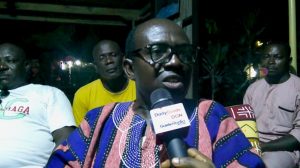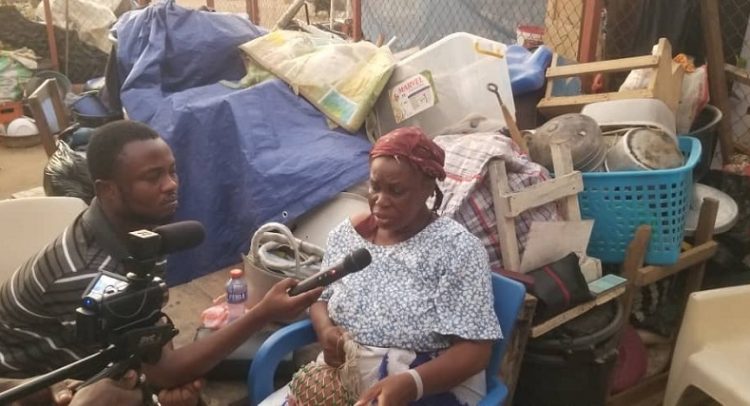Journalist interviewing displaced Liberian nationals
“We the traditional leaders of Gomoa Fetteh will do everything within our power to ensure that the Liberians move out of the Budumburam areas to get the place developed” – Nana Kow Mensah Ababio II, Odikro, Kasoa in the Gomoa Fetteh Traditional Area.
Over 6,000 Liberian residents in the Budumburam community were displaced following vigorous demolition exercises by the Gomoa Feteh Traditional Council.
As things stand now, women, children, the aged, and disabled persons were left stranded at the mercy of the weather with nowhere to call home to seek shelter; their calls for support having proved futile.
The traditional authorities, who according to them have exhausted their compassion for the Liberians, deliberately undertook this emergency demolition exercise as a move to reclaim over 170 acres of land being occupied by the Liberian nationals.
The reclamation, they added, is to pave the way for the reconstruction of facilities to give the community a befitting status.

Mr Solomon Darko Quarm
The Budumburam Liberian Camp area is notoriously known as a refugees’ camp where criminal activities are rife.
According to the traditional authorities the prevalence of criminal activities in the community has prevented foreign investors from establishing businesses in the community.
The frustration of the traditional authorities and others led to the coinage of “Liberians Must Go,” and this has resonated in the community since 2020 culminating eventually in the demolition exercise on February 27, which affected thousands of homes.
Nana Kow Mensah Ababio II said after the United Nations High Commissioner for Refugees (UNHCR) announced in 2012 the cessation of hostilities in their country Liberians were advised to return to their home country.
“It is not true the allegations by the Liberians that the chiefs did not inform them before undertaking the demolition exercises. For the last three to four years now, the traditional authorities have issued various notices informing them of our intentions to demolish the site,” said the chief.
Displaced Liberians at the camp
The chief recalled instances where lands belonging to the traditional authorities were sold by the Liberian refugees to Ghanaians using forged documents. “The refugees have abused their stay in the country; reason we think they must return to their country,” he said.
This accusation according to the Executive Secretary of the Ghana Refugee Board, Tetteh Padi, cannot be possible without the support of persons in the traditional authority.
Nana Kow Mensah Ababio II said that on various occasions, the Interior Ministry intervened whenever a demolition was going to be undertaken.
Following the government expansion project of the Winneba-Cape Coast Highway to reduce traffic congestion, the traditional authority capitalised on the opportunity to demolition the camp.
Nana Kow Mensah Ababio II said, “Our women are now using the roadside areas for hawking to prevent any unforeseen circumstances.”
Gomoa East District Assembly, District Chief Executive (DCE) for the Area, Mr. Solomon Darko Quarm, who described the displaced Liberians as squatters, pointed out the unwavering support from the assembly to the traditional authorities to develop the community.
Overseas Dream
Amidst these challenges, displaced Liberians at the camp have set their sights on seeking asylum overseas after 35 years of seeking refuge locally in Ghana.
The unexpected demolition has shattered their homes and livelihoods, fueling their desire to start anew in countries like the UK, Canada, and other European nations.
Theresa Wulla, a disabled woman and professional hairdresser, was among the refugees who sought sanctuary in the Budumburam Liberian camp in 1990. For decades, Theresa, confined to a wheelchair, resided in zone four of the camp before the recent demolition activities unfolded.
During the interview, she was occupying one of the classrooms constructed by fellow Liberian nationals. Madam Theresa finds herself in a precarious situation with nowhere to turn to.
“If they come to demolish the school, I fear I will be left on the streets,” she lamented, adding, “The traditional leaders failed to provide advance notice of the demolition, catching residents off guard as bulldozers tore through their homes.’
Theresa managed to salvage only her wheelchair as everything else was lost in the demolition.
Despite the challenges, some individuals and charitable organisations, according to Theresa, have stepped in to provide food and water for her and others in similar circumstances.
Expressing her desire not to be repatriated to Liberia, Theresa yearns for relocation to a European country where she can access quality healthcare.
Lawrence Good, a student, voiced his dismay at the traditional leaders for dismantling their school without considering the impact on their future. “We are deeply hurt and disappointed because our school was destroyed, leaving young children homeless,” he said.
Lawrence highlighted the plight of elderly individuals now stranded on the streets without shelter, emphasising the urgent need for assistance. “We are in dire need of help – lacking food, schools, and shelter. Our mental well-being is severely affected, and we implore you to assist us by relocating us to places where we can find refuge. I aspire to further my education in countries like the UK and USA,” Lawrence expressed, echoing the shared desire for a chance at a better future beyond the Budumburam camp.
Journey to Liberia
Following the demolition of the camp in February 27, 2024, 707 Liberian refugees from Ghana out of the 4,300 expected returnees got to Liberia through the Luogatuo Border in Nimba County. This was according to a news publication by The New Dawn.
The first batch of Liberians from the Buduburam refugee camp returned Liberia on May 21, 2024 marking a significant milestone in the Liberian Government’s efforts to repatriate its citizens through the Liberian Refugee Repatriation and Resettlement Commission (LRRRC).
Upon arrival in Liberia through the Luogatuo border, the returnees were received by Bong County Senator, Johnny Kpehe, along with the Bong County Superintendent and Police Director.
Ahead of the repatriation, the Executive Secretary of the Ghana Refugee Board, Tetteh Padi, confirmed in an interview stated that the relocation of Liberian refugees from the Buduburam Refugee Camp is underway, with approximately 150 individuals successfully transported to a new facility in the Western Region of Ghana.
“Yes, we’ve provided the opportunity for all of them to be transported,” the Executive Secretary stated. “However, not everyone came forward, but about 150 refugees were relocated, while 262 expressed interest in enjoying same opportunity.”
The relocated individuals are now housed in shelters specifically designated for refugees, including those from other countries.
The Executive Secretary acknowledged that many structures were in various states of disrepair. “We have space and structures available, but not all are in good condition,” he explained. “We are actively working on refurbishing and rehabilitating those that require repairs to ensure they can adequately house the refugees.”
The relocation initiative aims to provide a more stable environment for refugees as they transition back to live in Ghana, he said adding that “the Ghana Refugee Board continues to monitor the situation and ensure that all necessary accommodations are made for those affected.”
Mr. Tetteh Padi reiterated that the Liberian camp has ceased to be a refugee camp.
Refugees will be given the option to relocate to either the Ampain or Krisan Refugee Camps in the Western Region.
Since their repatriation on May 21 back home, an expected 4,300 returnees have arrived safely in their individual towns in Liberia.
News has it that upon their arrival they behaved unruly, resulting in a fight and one person sustaining injury.
According to report by The New Dawn publication, these returnees are seen smoking wee in Sanniquellie and have been investigated by officers of the Liberia Drugs Enforcement Agency.
It now behooves the LRRRC to ensure that the returnees live a meaningful life in Liberia. In an effort to resettle them, they should ensure that dignified housing and financial supports are provided to them access to healthcare facilities, education and vocational training.
The LRRRC should also incorporate into their reintegration plan sensitisation campaigns that foster community acceptance, encourage social cohesion through cultural events, provide legal assistance for documentation and support their participation in local governance.
By performing these roles, the LRRRC can ensure repatriated refugees reintegrate successfully and leave a meaningful life in Liberia.
Background
The first civil war in Liberia erupted on December 24, 1989, instigated by the National Patriotic Front of Liberia (NPFL), led by Charles Taylor, who launched an offensive against Doe’s forces.
By early 1990, tens of thousands of Liberians had fled the country, after enduring atrocities such as rape, torture, and killings, as government and rebel forces engaged in prolonged conflict. Liberians seeking refuge arrived in Ghana around May 1990 on evacuation flights meant for Ghanaian nationals leaving Liberia.
The United Nations High Commissioner for Refugees (UNHCR) established the Budumburam Refugee Camp to house over 12,000 individuals. While the UNHCR limited directed assistance to certain groups, it supported community projects like infrastructure development and education.
Despite the UNHCR’s gradual reduction of aid from 1997 and its complete withdrawal by June 30, 2000, Liberians continued to reside in Ghana, adapting by engaging in entrepreneurial activities for survival due to the lack of humanitarian support.
In February 2011, Ghana’s Deputy Minister of Information suggested that Buduburam residents consider returning to Liberia or settling elsewhere in Ghana.
As of May, around 11,000 refugees remained in Ghana. In 2021, chiefs in Gomoa Fetteh demanded the immediate demolition of Budumburam to combat criminal activities. Despite appeals to the president for its demolition, no action was taken.
Consequently, on February 27, the Gomoa Feteh Traditional Council demolished the camp to make room for a community market and to expand the Kasoa Winneba Highway, displacing over 600 Liberians.
By Prince Fiifi Yorke


